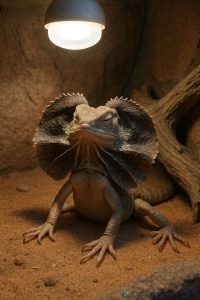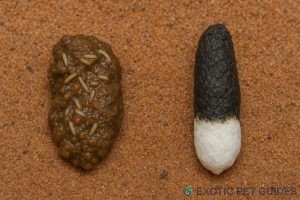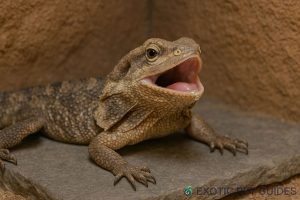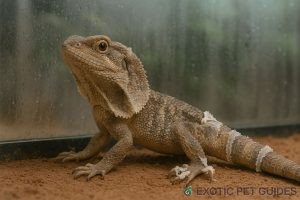Frilled Dragons are generally hardy reptiles, but improper care can quickly lead to health problems. Early detection is key, as many reptile illnesses progress silently. In this article, we’ll go over the most common health issues, how to prevent them, and when to seek veterinary care.
🧪 1. Metabolic Bone Disease (MBD)
Cause: Calcium or vitamin D3 deficiency, poor UVB exposure.
Symptoms:
- Soft or swollen jaw
- Limping or twitching limbs
- Lethargy
- Curved spine or tail
Prevention:
- Provide high-quality UVB lighting (10.0 strength, changed every 6–12 months)
- Dust feeders with calcium + D3 3× per week
- Maintain proper basking temps for digestion (100–110°F)

🦠 2. Parasites (Internal and External)
Internal parasites (worms, protozoa) and external parasites (mites, ticks) can come from wild-caught prey, dirty cages, or infected animals.
Symptoms:
- Weight loss despite eating
- Runny or discolored stool
- Visible mites around eyes or vent
- Lethargy, dehydration
Prevention:
- Never feed wild-caught insects
- Quarantine new reptiles for at least 30 days
- Clean enclosure weekly, disinfect monthly

🌡️ 3. Respiratory Infections (RI)
Cause: Low temperatures, high humidity, poor ventilation.
Symptoms:
- Wheezing, clicking sounds
- Gaping mouth while resting
- Mucus around nose or mouth
- Loss of appetite
Prevention:
- Keep basking area at 100–110°F
- Avoid prolonged high humidity (>70%)
- Ensure air circulation within the enclosure

💩 4. Impaction
Cause: Ingesting substrate, too many hard-shelled insects (e.g. mealworms), low temps.
Symptoms:
- No bowel movement for several days
- Swollen belly
- Lethargy, dragging hind legs
Prevention:
- Avoid loose substrates like sand
- Feed softer insects (dubia, silkworms)
- Maintain proper temps for digestion
Emergency tip: Warm baths and belly massages may help, but vet care is best if no stool in 5+ days.
🧼 5. Shedding Issues (Dysecdysis)
Frilled Dragons usually shed smoothly, but low humidity or poor hydration can cause stuck shed.
Common stuck areas:
- Toes
- Tail tip
- Frill edges
Treatment:
- Increase humidity slightly during shedding (55–65%)
- Offer moist hide or gentle warm baths
- Never peel stuck skin forcefully

🆘 When to See a Reptile Vet
Call a reptile specialist vet if your dragon shows any of the following:
- Refuses food for more than 7–10 days
- Cannot move limbs normally
- Has visible injuries, wounds, or abnormal growths
- Shows any signs of infection (puffing, mucus, wheezing)
Keep a record of temperature, humidity, diet, and behavior to help the vet diagnose properly.
✅ Quick Checklist for Frilled Dragon Health
| Item | Ideal Range/Action |
|---|---|
| Basking Temp | 100–110°F |
| Humidity | 50–60% (slightly higher during shedding) |
| UVB Bulb | 10.0 strength, replace every 6–12 months |
| Supplement Schedule | Calcium w/ D3 (3×/week), Multivitamins (1×/week) |
| Vet Visit | Annual check-up or at first sign of illness |